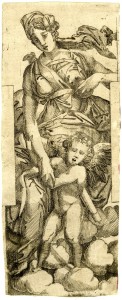Etching, Anonymous, 27.8 x 11.4 S; 27.7 x 11.4 L (London).
Fig.E.152 (London)
COLLECTION: London, W.3-118 (Prints after Rosso), slightly irregularly cut and the lower right corner missing, but the outline is mostly preserved, indicating the image is complete.
LITERATURE:
Carroll, 1978, 48, n. 29, as after a drawing by Rosso for the decoration of the Salle Haute at Fontainebleau.
Carroll, 1987, 11, 332-333, 335, n. 11, under no. 104, as after a drawing for the decoration of the Salle Haute.
Stylistically, the figure of Venus, who holds the golden ball awarded her by Paris, is similar to several figures by Rosso in the Gallery of Francis I, including Minerva in the Venus and Minerva (Fig.P.22, I N a), the women in the Death of Adonis (Fig.P.22, III S b), and, in her costume, the mother in the Cleobis and Biton (Fig.P.22, V S a). Although the etching is somewhat schematically executed, the oval face of Venus, with the hair parted in the middle and coming down diagonally left and right across the forehead, and with the plane of the forehead continuous with that of the bridge of the nose, is very much like that of the faces of the women in Rosso’s Pietà in the Louvre (Fig.P.23a). The child resembles the figure of Christ in Rosso’s painting in Los Angeles (Fig.P.24a). On the basis of these correspondences, the image of this etching can be attributed to Rosso.
But the print can also be related to Rosso’s drawing of Apollo in the Louvre (Fig.D.76Aa), which shows the same unusual kind of lateral indentions of the format of the image. The two works also have the same proportions, although the drawing is composed of half-circles at the top and bottom while the print is squared. It is very likely that the Venus and Cupid, and the Apollo, are related to Rosso’s lost decoration of the Salle Haute in the Pavillon des Poêles at Fontainebleau, a project that was probably begun in 1537 or 1538 (L.43), and to which can be joined a Diana Shooting with Her Bow (Fig.E.61).
The lost model for the Venus and Cupid print was probably a drawing by Rosso rather than the lost fresco itself, as is generally the case with the prints made from his works, including the anonymous print (Fig.E.151) after the Apollo drawing. That print is in the same direction as the drawing. The major gestures in the Venus and Cupid suggest that it also is not reversed, but this cannot be known with certainty.

